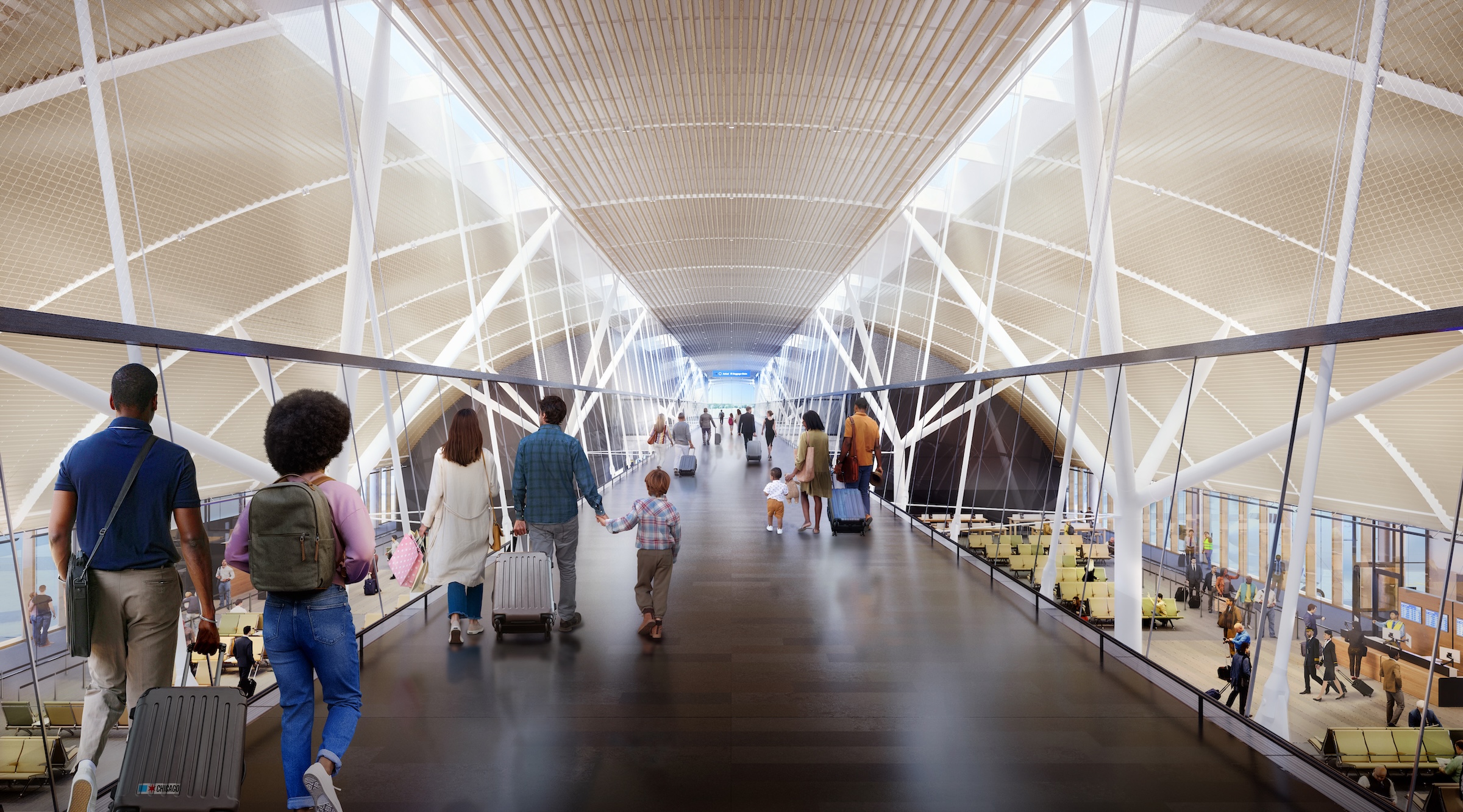The Chicago Department of Aviation has revealed the design for Satellite Concourse 1 at O’Hare International Airport, one of the nation’s business airports.
Designed by Skidmore, Owings & Merrill (SOM), with Ross Barney Architects, Juan Gabriel Moreno Architects (JGMA), and Arup, the concourse will be the first new building in the Terminal Area Program, the largest concourse area expansion and revitalization in the airport’s almost seven-decade history.
The Terminal Area Program includes two new satellite concourses, a new O’Hare Global Terminal replacing Terminal 2, and an underground tunnel connecting the facilities.
Satellite 1 will be one of Chicago’s first domestic-international codeshare concourses. It will accommodate different aircraft bodies, providing operational efficiency for both carriers and layover passengers.
“We designed the new satellite concourse to create a frictionless experience for travelers, on par with the best airports in the world,” Scott Duncan, SOM design partner, said in a statement.
The gate lounges will offer ample daylighting, column-free expanses for easy wayfinding, and high ceilings to improve views and air circulation—“all to make the experience of air travel more pleasurable,” Duncan said.

Inspired by the orchard that gave O’Hare its original name (“Orchard Field”), the design features a tree-like structural system inside the concourse. This system eliminates almost half the columns at the gates, reducing congestion and enabling more efficient boarding and better visibility.
The branching structural system also reduces the building’s embodied carbon. The curved roof minimizes heating and cooling needs, with overhanging to create shade during peak sun conditions. Central skylights create daylit waiting areas year-round. And high-performance mechanical and electrical systems reduce energy use.
A connection from the existing Concourse C will drop passengers in an atrium where they can wait in a garden-like setting below a skylight. The interior features a natural palette with sound-absorbing materials.
The SOM-led team was selected in 2019 to design the airport’s two satellite terminals. Despite the pandemic-related challenges for the airline and construction industries, the design for Satellite 1 is currently under budget and on track for construction. Onsite pre-construction work is under way.
On the Building Team:
Owner: City of Chicago
Design architects: Skidmore, Owings & Merrill (SOM) with Ross Barney Architects, Juan Gabriel Moreno Architects (JGMA)
Structural engineers: SOM with Arup and Rubinos & Mesia Engineering (RME), Inc.
Construction managers: AECOM Hunt Clayco Bowa



Related Stories
| May 19, 2014
What can architects learn from nature’s 3.8 billion years of experience?
In a new report, HOK and Biomimicry 3.8 partnered to study how lessons from the temperate broadleaf forest biome, which houses many of the world’s largest population centers, can inform the design of the built environment.
| May 13, 2014
19 industry groups team to promote resilient planning and building materials
The industry associations, with more than 700,000 members generating almost $1 trillion in GDP, have issued a joint statement on resilience, pushing design and building solutions for disaster mitigation.
| May 11, 2014
Final call for entries: 2014 Giants 300 survey
BD+C's 2014 Giants 300 survey forms are due Wednesday, May 21. Survey results will be published in our July 2014 issue. The annual Giants 300 Report ranks the top AEC firms in commercial construction, by revenue.
| Apr 29, 2014
USGBC launches real-time green building data dashboard
The online data visualization resource highlights green building data for each state and Washington, D.C.
| Apr 22, 2014
Bright and bustling: Grimshaw reveals plans for the Istanbul Grand Airport [slideshow]
In partnership with the Nordic Office of Architecture and Haptic Architects, Grimshaw Architects has revealed its plans for the terminal of what will be one of the world's busiest airports. The terminal is expected to serve 150 million passengers per year.
| Apr 9, 2014
Steel decks: 11 tips for their proper use | BD+C
Building Teams have been using steel decks with proven success for 75 years. Building Design+Construction consulted with technical experts from the Steel Deck Institute and the deck manufacturing industry for their advice on how best to use steel decking.
| Apr 4, 2014
$25 million Orion Jet Center designed by SchenkelShultz now open
As the centerpiece of the 45-acre campus, which is its first phase of a planned 215-acre mixed-use development, the 18,000 square foot executive terminal facility offers spacious passenger areas, administrative space, an executive suite, rental car kiosk, catering and a cafe.
| Apr 2, 2014
8 tips for avoiding thermal bridges in window applications
Aligning thermal breaks and applying air barriers are among the top design and installation tricks recommended by building enclosure experts.
| Mar 26, 2014
Callison launches sustainable design tool with 84 proven strategies
Hybrid ventilation, nighttime cooling, and fuel cell technology are among the dozens of sustainable design techniques profiled by Callison on its new website, Matrix.Callison.com.
| Mar 20, 2014
Common EIFS failures, and how to prevent them
Poor workmanship, impact damage, building movement, and incompatible or unsound substrate are among the major culprits of EIFS problems.

















